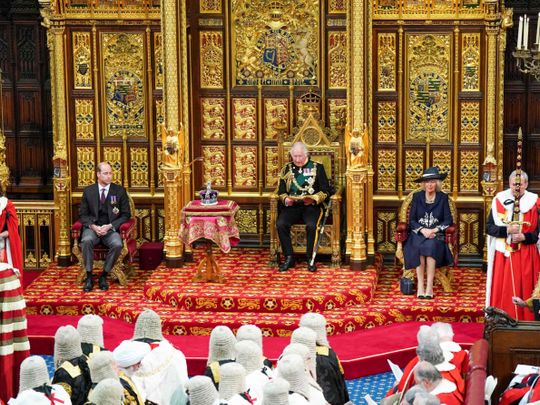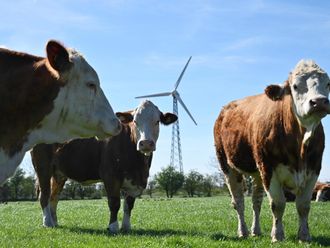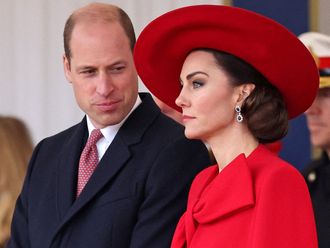
London: Head of state Queen Elizabeth II missed Tuesday’s ceremonial opening of the UK parliament for the first time in nearly 60 years, handing the duty to her heir Prince Charles in a clear sign of the looming transition of power.
The queen’s decision to delegate her role to Charles is likely to be seen by the public as evidence that a transition is underway, with the 96-year-old monarch remaining on the throne but turning over more responsibilities to Charles.
“The heir is teetering on the edge of becoming a de facto prince regent. William will observe what awaits him,’’ said former BBC royal reporter Peter Hunt. “With the queen progressively withdrawing from public life, the palace is keen to show the monarchy is safe in the hands of father and son.’’
The monarch usually presides over the pomp-filled event and reads out her government’s legislative programme from a gilded throne in the House of Lords.
But Buckingham Palace said late Monday she would skip the annual showpiece on medical advice, making the decision “reluctantly” as she continues to experience “episodic mobility problems”.
It is the latest in a string of cancelled public appearances caused by health problems and old age indicating her record-breaking 70-year reign is drawing to a close.
Charles, the Prince of Wales, was accompanied at the high-profile state engagement by his eldest son, Prince William, who is second-in-line to the throne.
William, the Duke of Cambridge, arrived ahead of his father, wearing a morning suit and military medals as he was escorted through parliament.
Charles, wearing full military regalia, waved to crowds as he made his way by car to the Palace of Westminster with wife Camilla, Duchess of Cornwall.
The national anthem, “God Save the Queen”, played as he arrived at parliament, before a royal trumpet fanfare struck up as he stepped out of the vehicle.
The royal procession entered the House of Lords behind the imperial state crown - usually worn by the queen - which was carried into the chamber on a cushion before being placed on a small table.
Charles delivered the Queen’s Speech from the consort’s throne, symbolically an inch shorter than the monarch’s sovereign throne, and was flanked by his wife and son as he read out the government’s agenda.
‘Historic moment’
The queen has rarely been seen in public since spending an unscheduled night in hospital last October, and has complained of difficulties standing and walking. She also contracted Covid-19 in February.
She has missed only two state openings - in 1959 and 1963, when she was pregnant with Prince Andrew and then Prince Edward.
The speech is written by the elected government, currently led by Prime Minister Boris Johnson.
It is delivered during the state opening of Parliament. The monarch traditionally arrives in a horse-drawn carriage, sits on the Sovereign’s Throne in the House of Lords and wears the Imperial State Crown
But Charles, 73, sat not on the sovereign’s throne, which had been removed, but on the consort’s throne, which had been used by his father, Prince Philip. In the place where the queen’s throne normally is placed, the Imperial State Crown was place on a velvet cushion.
Charles delivered the speech in the third person, using “Her Majesty’s Government.’’
WHY DID ELIZABETH DECIDE TO SKIP THE SPEECH?
Buckingham Palace didn’t elaborate on what it called “episodic mobility problems,’’ but the queen has had difficulty moving around in recent months. She has been seen using a cane on some occasions and Prince Andrew escorted her into Westminster Abbey for the memorial service for her late husband, Prince Philip, last month.
That said, the speech involves more than just reading the remarks. There is long walk to the House of Lords, stairs to her throne — and in times past, carriages. All of these obstacles might offer a challenge for the sovereign.
Elizabeth, who only recently recovered from a bout of COVID-19, is also preparing for four days of festivities celebrating her Platinum Jubilee that are scheduled for June 2-5.
HAS THE QUEEN EVER MISSED THE SPEECH BEFORE?
Yes. In 1959, when she was in the late stages of pregnancy with Prince Andrew, and again in 1963 before the birth of Prince Edward.
On both of those occasions, Parliament was opened by a royal commission, with the speech delivered by the presiding member.
SO WHAT’S DIFFERENT THIS TIME?
This year the queen has formally asked Prince Charles to deliver the speech under rules that allow her to delegate some of her duties to senior members of the royal family who are considered “counselors of state.’’ Counselors of state are required to act in pairs, so Charles was accompanied by his eldest son, Prince William.
Her decision heightened fears that she may not be able to play a full part in public celebrations next month celebrating her Platinum Jubilee.
Royal expert Robert Hardman wrote in the Daily Mail that the queen “remains very much in charge” but called the handover a “historic moment”.
The Times wrote that for Charles - the longest-serving heir to the throne in British history - this is “the nearest he has come to performing the duties he will one day undertake as king”.
It is William’s first time attending the state opening, in another clear sign of the family preparing for a future beyond Elizabeth and Charles.
The queen announced last week she will not attend this summer’s royal garden parties, and has only appeared once in public since October - at the March 29 memorial service for her late husband Prince Philip, who died last year aged 99.
‘Back on track’
The queen’s absence overshadowed the start of the new parliamentary session in which Prime Minister Boris Johnson tried to reinvigorate his faltering government by unveiling its plans for the coming year.
Reeling from a series of scandals and dire results for his ruling Conservatives in local elections last week, he is promising 38 bills to get his agenda “back on track”, Downing Street said.
The plan is focussed on boosting economic growth and paving the way for more “high-wage, high-skill jobs”, as well as tackling the spiralling cost of living.
The upcoming parliamentary session - the current government’s third - is one of Johnson’s last opportunities to deliver on his key policy promises before the next general election due by May 2024.
Johnson won an 80-seat majority in December 2019, vowing to reap rewards from Brexit and tackle decades of growing regional inequality.
Despite securing Britain’s withdrawal from the EU with a comprehensive trade deal, the coronavirus pandemic upended delivery of his domestic agenda.
His government was soon consumed by the pandemic and then sidetracked in recent months by various controversies, including the so-called “Partygate” scandal.
That saw Johnson become the first UK prime minister found to have broken the law while in office, after police ruled he and staff had breached Covid-19 lockdown rules.
He is now hoping his legislative programme can help draw a line under his recent woes.
But he faces a daunting challenge as the growing cost-of-living crisis begins to bite, with bleak economic forecasts.












